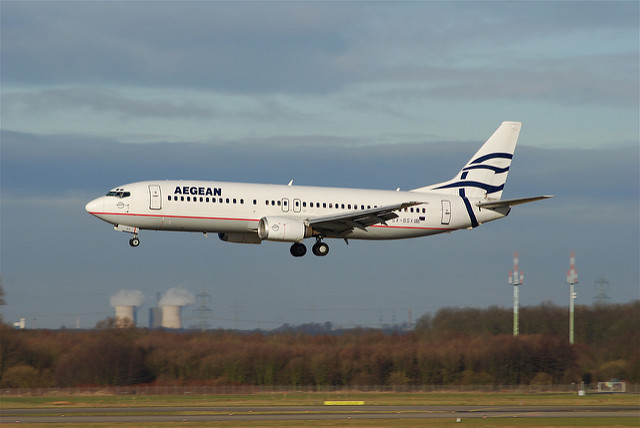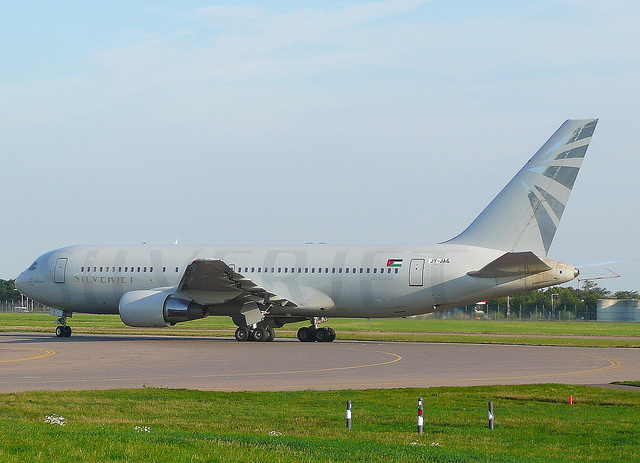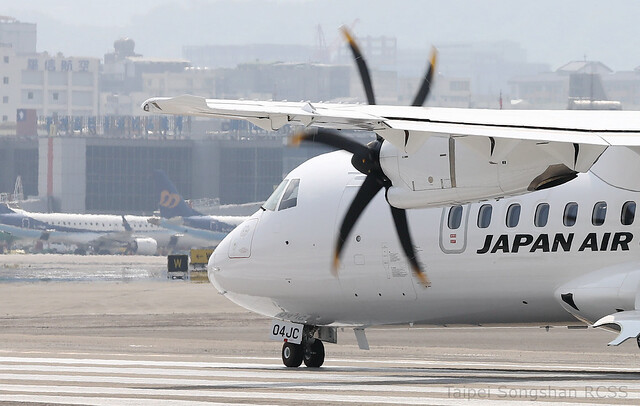Jordan B734 at Kabul on Dec 10th 2016, hard landing causes right main gear collapse
Last Update: December 21, 2018 / 16:47:58 GMT/Zulu time
Incident Facts
Date of incident
Dec 10, 2016
Classification
Accident
Cause
Hard landing
Airline
Jordan Aviation
Flight number
4Q-502
Departure
Herat, Afghanistan
Destination
Kabul, Afghanistan
Aircraft Registration
JY-JAQ
Aircraft Type
Boeing 737-400
ICAO Type Designator
B734
The runway and aerodrome are closed.
The airline reported the aircraft made a hard landing at Kabul and suffered a burst tyre. All 155 people on board were evacuated safely.
Media in Afghanistan reported the aircraft performed an emergency landing reporting technical problems.
Jordan's Civil Aviation Regulatory Commission (CARC) released their final report concluding the probable cause of the accident was:
The Investigation committee determines that the airplane occasionally experienced main landing gear shimmy and the most probable cause indicated that the struts were extended for long period of time. As a result, the torsion link of the shimmy damper remained in an extended vertical position, where the damper has less mechanical advantage for longer periods of time. Despite the presence of shimmy damper hardware which is designed to reduce the torsional vibration energy generated during landing.
The CARC reported the aircraft performed an ILS approach to runway 29 (gidepath at 3.5 degrees), flaps 30 were set, Vref had been computed to 142 KIAS and Vapp was computed to 152 KIAS. Air Traffic Control reported the winds from 190 degrees at 15 knots. Between 950 and 75 feet AGL the aircraft maintained a rate of descent above 1000 fpm (average 1250 fpm), the glideslope indicated low. At 35 feet AGL the flare was initiated. A few seconds after touch down at 158 KIAS (and 178 knots over ground) and 180 fpm rate of descent about 3500 feet past the runway threshold the crew felt vibrations, they applied brakes and reverse thrust. The aircraft rolled slighty to the right about 4700 feet past the runway threshold and came to a stop about 20 feet left of the runway center line and about 10450 feet past the runway threshold resting on the left main gear and right engine, the nose gear was in the air. Emergency services responded and foamed the right hand engine, an emergency evacuation was performed through the left hand doors with no injuries.
The CARC reported the aircraft sustained substantial damage, there were no injuries.
The CARC analysed:
Below 1000 feet radio altitude, the flight crew did not adhere to two of the above recommended stabilized approach criteria. These criteria are summarized below:
- Sink rate is no greater than 1000 fpm. Throughout the approach, there were several sink rate exceedance of 1000 fpm.
The CVR data show that a “Sink Rate” warning was triggered for 2 seconds between 159 - 115ft AAL. The average Vertical speed during the warning was -1093 ft/min.
This rate of descent warnings is normal on approach to a high altitude airport with a steep (3.5 degree glideslope) due to the higher True Airspeed and consequent higher Groundspeed. The rate of descent required to maintain a 3.5 degree glideslope with a Groundspeed of 180Kts is 1064ft/min.
- The flight crew selected an approach speed of Vapp+10, while the ATC a wind of 140/07 which indicates a tailwind component of 6 knots, the crew should select Vapp+5 at that stage.
Although they were selecting Vapp+10, the FDR data was showing an average of 165-170 knots IAS which is 15 – 18 knots higher than the selected approach speed, and that speed deviation continued until the aircraft reached the flare height were the trends went down towards a speed of Vapp+5.
With respect to the shimmy damper the CARC analysed:
The characteristics of the landing are consistent with past landing gear shimmy events. The airplane touched down at a high ground speed and low sink rate, and the air/ground discrete transition to GROUND occurred approximately 1 to 1.5 seconds after initial main gear ground contact, indicating that the struts were extended for that period of time. As a result, the torsion links of the shimmy damper remained in an extended, vertical position, where the damper has less mechanical advantage for longer periods of time. Despite the presence of shimmy damper hardware, which is designed to reduce the torsional vibration energy generated during landing, airplanes occasionally experience main landing gear shimmy. As a result, the torsion links of the shimmy damper remained in an extended, vertical position, where the damper has less mechanical advantage for longer periods of time.
Related NOTAM:
(G0175/16 NOTAMR G0168/16
Q) OAKX/QMRLC/IV/NBO/A/000/095/343357N0691245E006
A) OAKB B) 1612100845 C) 1612110600 EST
E) RWY 11/29 CLSD DUE TO ACFT CRASH.)
Metars:
OAKB 101050Z 21011KT 9999 SCT080 10/M01 Q1014 NOSIG RMK BLU BLU
OAKB 100950Z 19012KT 9999 SCT050 11/M00 Q1014 NOSIG RMK BLU BLU
OAKB 100850Z 21016G31KT 8000 SCT080 10/01 Q1014 NOSIG RMK BLU WHT
OAKB 100750Z 15009KT 6000 BKN040 09/03 Q1015 NOSIG RMK WHT WHT
OAKB 100650Z 14007KT 5000 BR BKN030 07/03 Q1016 NOSIG RMK WHT WHT
OAKB 100550Z 14016KT 4000 -SHRA BR BKN030 07/03 Q1016 NOSIG RMK WHT WHT
OAKB 100515Z 12014G24KT 4000 SHRA BR BKN050 08/02 Q1013 NOSIG RMK GRN GRN
Incident Facts
Date of incident
Dec 10, 2016
Classification
Accident
Cause
Hard landing
Airline
Jordan Aviation
Flight number
4Q-502
Departure
Herat, Afghanistan
Destination
Kabul, Afghanistan
Aircraft Registration
JY-JAQ
Aircraft Type
Boeing 737-400
ICAO Type Designator
B734
This article is published under license from Avherald.com. © of text by Avherald.com.
Article source
You can read 2 more free articles without a subscription.
Subscribe now and continue reading without any limits!
Read unlimited articles and receive our daily update briefing. Gain better insights into what is happening in commercial aviation safety.
Send tip
Support AeroInside by sending a small tip amount.
Related articles
Jordan B734 at Tombouctou on May 5th 2017, overran runway on landing
A Jordan Aviation Boeing 737-400, registration JY-JAP performing flight R5-7843 from Bamako to Tombouctou (Mali) with 90 passengers and 11 crew, was…
Jordan B762 at Islamabad on Feb 15th 2015, engine shut down in flight
A Jordan Aviation Boeing 767-200 on behalf of Shaheen, registration JY-JAG performing flight NL-739 from Islamabad (Pakistan) to Riyadh (Saudi…
Newest articles
JAC AT42 at Amami on Jan 5th 2026, hydraulic failure
A JAC Japan Air Commuter Avions de Transport Regional ATR-42-600, registration JA04JC performing flight JL-3837 from Amami O Shima to Kikaiga Shima…
Emirates B772 over Saudi Arabia on Jan 4th 2026, loss of cabin pressure
An Emirates Boeing 777-200, registration A6-EWB performing flight EK-929 from Dubai (United Arab Emirates) to Cairo (Egypt), was enroute at FL360…
Subscribe today
Are you researching aviation incidents? Get access to AeroInside Insights, unlimited read access and receive the daily newsletter.
Pick your plan and subscribePartner

ELITE Simulation Solutions is a leading global provider of Flight Simulation Training Devices, IFR training software as well as flight controls and related services. Find out more.
SafetyScan Pro provides streamlined access to thousands of aviation accident reports. Tailored for your safety management efforts. Book your demo today
AeroInside Blog
Popular aircraft
Airbus A320Boeing 737-800
Boeing 737-800 MAX
Popular airlines
American AirlinesUnited
Delta
Air Canada
Lufthansa
British Airways



